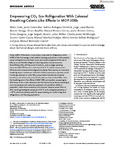Empowering CO2Eco-Refrigeration With Colossal Breathing-Caloric-Like Effects in MOF-508b

Use este enlace para citar
http://hdl.handle.net/2183/36514
A non ser que se indique outra cousa, a licenza do ítem descríbese como © 2023 The Authors. Advanced Materials published by Wiley-VCH GmbH. This is an open access article under the terms of the CreativeCommons Attribution-NonCommercial-NoDerivsLicense
Coleccións
- GI- INGEN-Artigos [18]
Metadatos
Mostrar o rexistro completo do ítemTítulo
Empowering CO2Eco-Refrigeration With Colossal Breathing-Caloric-Like Effects in MOF-508bAutor(es)
Data
2024Cita bibliográfica
M. Gelpi, J. García-Ben, S. Rodríguez-Hermida, J. López-Beceiro, R. Artiaga, Á. Baaliña, M. Romero-Gómez, J. Romero-Gómez, S. Zaragoza, J. Salgado-Beceiro, J. Walker, C. J. McMonagle, S. Castro-García, M. Sánchez-Andújar, M. A. Señarís-Rodríguez, J. M. Bermúdez-García, Empowering CO2 Eco-Refrigeration With Colossal Breathing-Caloric-Like Effects in MOF-508b. Adv. Mater. 2024, 36, 2310499. https://doi.org/10.1002/adma.202310499
Resumo
[Abstract] Today,≈20% of the electric consumption is devoted to refrigeration; while,≈50% of the final energy is dedicated to heating applications. In this scenario,many cooling devices and heat-pumps are transitioning toward the use ofCO2as an eco-friendly refrigerant, favoring carbon circular economy.Nevertheless, CO2still has some limitations, such as large operatingpressures (70–150 bar) and a critical point at 31°C, which compromisesefficiency and increases technological complexity. Very recently, an innovativebreathing-caloric mechanism in the MIL-53(Al) compound is reported, whichimplies gas adsorption under CO2pressurization boosted by structuraltransitions and which overcomes the limitations of stand-alone CO2. Here,the breathing-caloric-like effects of MOF-508b are reported, surpassing by40% those of MIL-53(Al). Moreover, the first thermometry device operating atroom temperature and under the application of only 26 bar of CO2ispresented. Under those conditions, this material presents values of𝚫������T≈30 K, reaching heating temperatures of 56°C and cooling temperatures of−10°C, which are already useful for space heating, air-conditioning, foodrefrigeration, and freezing applications.
Palabras chave
Barocaloric
Breathing-caloric
Metal–organic frameworks
Thermomaterials
Thermometry
Breathing-caloric
Metal–organic frameworks
Thermomaterials
Thermometry
Descrición
Financiado para publicación en acceso aberto: Universidade da Coruña/CISUG
Versión do editor
Dereitos
© 2023 The Authors. Advanced Materials published by Wiley-VCH GmbH. This is an open access article under the terms of the CreativeCommons Attribution-NonCommercial-NoDerivsLicense






